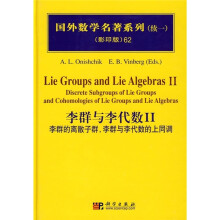Chapter 0. Introduction
Chapter 1. Discrete Subgroups of Locally Compact Topological Groups.
1. The Simplest Properties of Lattices
1.1. Definition of a Discrete Subgroup. Examples
1.2. Commensurability and Reducibility of Lattices
2. Discrete Groups of Transformations
2.1. Basic Definitions and Examples
2.2. Covering Sets and Fundamental Domains of a Discrete Group of Transformations
3. Group-Theoretical Properties of Lattices in Lie Groups
3.1. Finite Presentability of Lattices
3.2. A Theorem of Selberg and Some of Its Consequences
3.3. The Property (T)
4. Intersection of Discrete Subgroups with Closed Subgroups
4.1. T-Closedness of Subgroups
4.2. Subgroups with Good F-Heredity
4.3. Quotient Groups with Good F-Heredity
4.4. F-closure
5. The Space of Lattices of a Locally Compact Group
5.1. Chabautys Topology
5.2. Minkowskis Lemma
5.3. Mahlers Criterion
6. Rigidity of Discrete Subgroups of Lie Groups
6.1. Space of Homomorphisms and Deformations
6.2. Rigidity and Cohomology
6.3. Deformation of Uniform Subgroups
7. Arithmetic Subgroups of Lie Groups
7.1. Definition of an Arithmetic Subgroup
7.2. When Are Arithmetic Groups Lattices (Uniform Lattices)?
7.3. The Theorem of Borel and Harish-Chandra and the Theorem of Godement
7.4. Definition of an Arithmetic Subgroup of a Lie Group
8. The Borel Density Theorem
8.1. The Property (S)
8.2. Proof of the Density Theorem
Chapter 2. Lattices in Solvable Lie Groups
1. Discrete Subgroups in Abelian Lie Groups
1.1. Historical Remarks
1.2. Structure of Discrete Subgroups in Simply-Connected Abelian Lie Groups
1.3. Structure of Discrete Subgroups in Arbitrary Connected Abelian Groups
1.4. Use of the Language of the Theory of Algebraic Groups
1.5. Extendability of Lattice Homomorphisms
2. Lattices in Nilpotent Lie Groups
2.1. Introductory Remarks and Examples
2.2. Structure of Lattices in Nilpotent Lie Groups
2.3. Lattice Homomorphisms in Nilpotent Lie Groups
2.4. Existence of Lattices in Nilpotent Lie Groups and Their Classification
2.5. Lattices and Lattice Subgroups in Nilpotent Lie Groups
3. Lattices in Arbitrary Solvable Lie Groups
3.1. Examples of Lattices in Solvable Lie Groupsof Low Dimension
3.2. Topology of Solvmanifolds of Type R/T
3.3. Some General Properties of Lattices in Solvable Lie Groups
3.4. Mostows Structure Theorem
3.5. Wang Groups
3.6. Splitting of Solvable Lie Groups
3.7. Criteria for the Existence of a Lattice in a Simply-Connected Solvable Lie Group
3.8. Wang Splitting and its Applications
3.9. Algebraic Splitting and its Applications
3.10. Linear Representability of Lattices
4. Deformations and Cohomology of Lattices in Solvable Lie Groups .
4.1. Description of Deformations of Lattices in Simply-Connected Lie Groups
4.2. On the Cohomology of Lattices in Solvable Lie Groups
5. Lattices in Special Classes of Solvable Lie Groups
5.1. Lattices in Solvable Lie Groups of Type (I)
5.2. Lattices in Lie Groups of Type (R)
5.3. Lattices in Lie Groups of Type (E)
5.4. Lattices in Complex Solvable Lie Groups
5.5. Solvable Lie Groups of Small Dimension, Having Lattices.
Chapter 3. Lattices in Semisimple Lie Groups
1. General Information
1.1. Reducibility of Lattices
1.2. The Density Theorem
2. Reduction Theory
2.1. Geometrical Language. Construction of a Reduced Basis .
2.2. Proof of Mahlers Criterion
2.3. The Siegel Domain
3. The Theorem of Borel and Harish-Chandra (Continuation)
3.1. The Case of a Torus
3.2. The Semisimple Case (Siegel Domains)
3.3. Proof of Godements Theorem in the Semisimple Case ...
4. Criteria for Uniformity of Lattices. Covolumes of Lattices
4.1. Unipotent Elements in Lattices
4.2. Covolumes of Lattices in Semisimple Lie Groups
5. Strong Rigidity of Lattices in Semisimple Lie Groups
5.1. A Theorem on Strong Rigidity
5.2. Satake Compactifications of Symmetric Spaces
5.3. Plan of the Proof of Mostows Theorem
6. Arithmetic Subgroups
6.1. The Field Restriction Functor
6.2. Construction of Arithmetic Lattices
6.3. Maximal Arithmetic Subgroups
6.4. The Commensurator
6.5. Normal Subgroups of Arithmetic Groups and Congruence-Subgroups
6.6. The Arithmeticity Problem
7. Cohomology of Lattices in Semisimple Lie Groups
7.1. One-dimensional Cohomology
7.2. Higher Cohomologies
Chapter 4. Lattices in Lie Groups of General Type
1. Bieberbachs Theorems and their Generalizations
1.1. Bieberbachs Theorems
1.2. Lattices in E(n) and Flat Riemannian Manifolds
1.3. Generalization of the First Bieberbach Theorem
2. Deformations of Lattices in Lie Groups of General Type
2.1. Description of the Space of Deformations of Uniform Lattices
2.2. The Levi-Mostow Decomposition for Lattices in Lie Groups of General Type
3. Some Cohomological Properties of Lattices "
3.1. On the Cohomological Dimension of Lattices
3.2. The Euler Characteristic of Lattices in Lie Groups
3.3. On the Determination of Properties of Lie Groups by the Lattices in Them
References

 缺书网
缺书网 扫码进群
扫码进群




